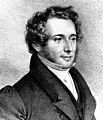I puritani facts for kids
I puritani (which means The Puritans) is a famous opera from Italy. It was written by Vincenzo Bellini and has three acts, like big parts of a play. The opera was first shown in Paris, France, on January 25, 1835.
The story for the opera, called the libretto, was written by Carlo Pepoli. He based it on a play called Têtes Rondes et Cavaliers, which means Roundheads and Cavaliers. That play was inspired by a book by Sir Walter Scott called Old Mortality. I puritani was Bellini's last opera and one of his biggest successes!
Contents
What is I puritani?
I puritani is a type of opera called bel canto, which means "beautiful singing." This style focuses on showing off the amazing voices of the singers. The music is often very flowing and emotional, with long, beautiful melodies. Bellini was a master at writing these kinds of tunes.
Who wrote I puritani?
The composer, Vincenzo Bellini, was born in Sicily, Italy. He was known for writing operas that were full of beautiful, sad, and romantic melodies. He wrote ten operas in total, and I puritani was his very last one. He finished it just a few months before he passed away.
The person who wrote the story and words for the opera, called the librettist, was Carlo Pepoli. He worked closely with Bellini to create the dramatic and emotional plot that the beautiful music would tell.
The Story of I puritani
The opera's story is set in England during a time of civil war in the 1640s. This was when King Charles I's supporters, called the Cavaliers, were fighting against the Parliament's army, called the Puritans or Roundheads.
The main characters are:
- Elvira: A young Puritan woman who is in love with a Cavalier.
- Arturo: A brave Cavalier knight who loves Elvira.
- Riccardo: A Puritan officer who also loves Elvira and is jealous of Arturo.
- Giorgio: Elvira's uncle, a kind Puritan who supports her love for Arturo.
The story is full of love, jealousy, and mistaken identities. Elvira is supposed to marry Riccardo, but she loves Arturo. Her uncle Giorgio helps her to be with Arturo. However, Arturo helps another woman, Queen Enrichetta, escape from prison. This makes everyone think he has betrayed Elvira. Elvira becomes very sad and confused, almost losing her mind. In the end, after many twists and turns, Arturo returns, and the truth comes out. The opera has a happy ending for the lovers, but it's a very emotional journey to get there!
Main Characters in the Opera
Here are the main singers you will hear in I puritani:
- Elvira - A young woman, sung by a soprano (a high female voice).
- Arturo - A brave knight, sung by a tenor (a high male voice).
- Riccardo - An officer, sung by a baritone (a middle-range male voice).
- Giorgio - Elvira's uncle, sung by a bass (a low male voice).
- Enrichetta - A queen, sung by a mezzo-soprano (a middle female voice).
- Bruno - A soldier, sung by a tenor.
- Gualtiero - A governor, sung by a bass.
Where and When is it Set?
The opera takes place in England around 1649, during the English Civil War. This was a time when the country was divided between two sides:
- The Puritans (also called Roundheads): These were supporters of the Parliament. They were often very strict in their religious beliefs and wore simpler clothes.
- The Cavaliers: These were supporters of King Charles I. They were known for their fancy clothes and loyalty to the king.
The story happens in a Puritan fortress near Plymouth. This historical setting adds a lot of drama and conflict to the love story.
Famous Music from the Opera
I puritani has many beautiful and challenging pieces of music. One very famous part is called "Credeasi, misera" from Act 3. It's known for being very difficult for the tenor singer, with some extremely high notes. Another well-known piece is Elvira's "Mad Scene," where her singing shows her deep sadness and confusion.
Images for kids
-
Cristina Trivulzio Belgiojoso 1832, by Francesco Hayez (detail)
-
Joan Sutherland and Luciano Pavarotti, 1976 performance at the Metropolitan Opera
-
An excerpt from "Credeasi, misera", act 3. The notes highlighted (above the high C) are among the highest demanded in tenor operatic repertoire and are usually sung falsetto or altogether transposed.
See also
 In Spanish: Los puritanos de Escocia para niños
In Spanish: Los puritanos de Escocia para niños









